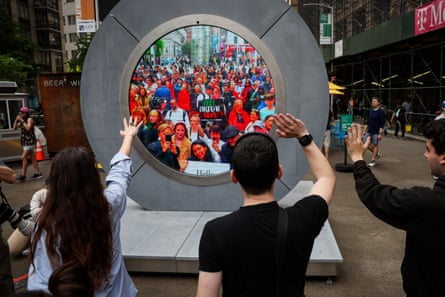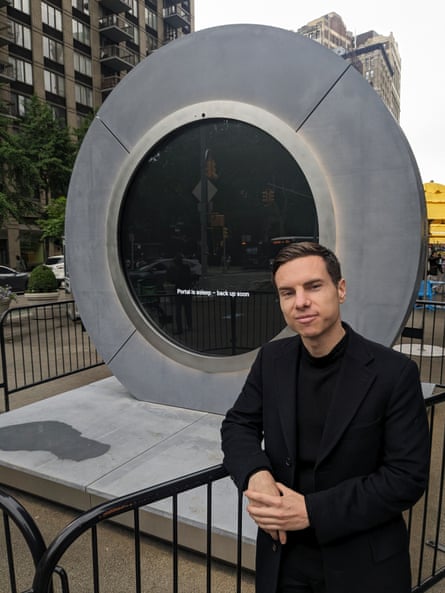The artist behind the controversial “Portal” art exhibit that visually linked New York and Dublin in real time, but was then closed due to rowdy and extreme behavior by the public using it, has admitted he was surprised by the reaction.
Benediktas Gylys also vowed to continue with his project, which has the aim of connecting people and communities all over the world and is hoped to reopen soon.
Whether it is possible for the New York-Dublin connection to run more smoothly when it does start up again is open to question. Gylys has floated the idea of some kind of monitoring software that turns the screen blurry for a few seconds if bad behavior is detected at the recently erected work in New York’s Madison Park.
Gylys, 34, says he and his small team were so focused on getting the 8ft tall sculpture installed and connected that they hadn’t given much thought to how it might be used – or misused.
“We were thinking about some potential incidences, and took some approaches, but now we see they were not enough,” he told the Guardian.
“But for me it is just us, the human species, building this artwork together and a representation of our current state of humanity,” he added. “We see a lot of love, light, smiles, a marriage proposal was made a couple of days ago, but we also have some darkness, attention-seeking, people who are only thinking about themselves, trying to jump on the narrative to get more views and followers.”
In fact, he says, there was no one incident that led to it being turned off. “It’s all part of the portal journey,” he said, but he’s hoping whatever the public may transmit across the Atlantic, they stop jumping on his sculpture. “It’s supposed to be family-friendly, to be enjoyed and looked after, not disrespected,” he said.
At the moment the text on the circular steel and poured concrete sculpture reads “Portal is asleep – back up soon”.
“Soon” is a loose term. It could be tomorrow. It could be Sunday. But whenever it is, the Lithuanian artist is hoping that the future of his whole project to connect humans to each other via international portals such as this one will be a smoother ride than it has been to date.
The Portal, as it is called, hit the headlines when New Yorkers in the Flatiron district began communicating with Dubliners on O’Connell Street, and vice versa, in ways that were perhaps not in the spirit of Gylys’s artistic objective that they “embrace the beauty of global interconnectedness”.

Days after the Portal came to life on 8 May, it was abruptly switched off after the OnlyFans model Ava Louise hitched up her top to Dubliners because she “thought the people of Dublin deserved to see two New York, homegrown potatoes”.
That, New York and Dublin authorities decided, was more communication than they had intended to be transmitted. But there were other problems too. Dubliners held up swastikas and displayed images of New York’s twin towers burning on 9/11.
The Portal went dark.
In a statement on Tuesday, a spokesperson for the Flatiron NoMad Partnership, a sponsor of the sculpture, said that “instances of inappropriate behavior have come from a very small minority of Portal visitors and have been amplified on social media.”
Dublin city council said that although those who engaged in the inappropriate behavior were few and far between, videos of the controversial behavior went viral online.
“While we cannot control all of these actions, we are implementing some technical solutions to address this and these will go live in the next 24 hours,” the council said in a statement, adding it would “continue to monitor the situation” to “ensure that portals continue to deliver a positive experience for both cities and the world”.
Gylys hopes that the intent of the sculpture is recovered and his ambition to connect cities around the world. The US to Ireland was not the first in the series: Lithuania to Poland was in 2021.
But the Lithuanians and Poles showed less flair for contentious gesticulation.
“Everyone is obsessed about Dublin and New York, but I’m trying to communicate a message that it’s not only about New York and Dublin, but about countries around the world joining the portal network to create the largest artwork in the world.”

If they can get it working, subject to human nature, the Dublin portal is set to connect with other cities and destinations, including Brazil, which will be next.
Gylys says that in 2015 he was searching for life’s meaning, depressed, and admitted to himself that he knew nothing about life. He came to feel united with all living beings and it became difficult for him, he says, “to experience the world with narratives of separation and conflict”.
So the idea of an interconnected “Portal” was born.
But even in its darkened state last week, the Portal is still attracting visitors in New York. Aaron Cohen, who described himself as an actor and satirist, said it had brought publicity and visitors to the neighborhood.
Cohen, 72, said it had brought unity because people could see what everybody does in Ireland or New York on a daily basis. “It was a good idea, but unfortunately people took advantage of it and it brought out their lewd side. People got carried away.”
He said authorities should have expected that “because in a crowd of everyday people there would be some who don’t act appropriate”. If the new censor filters work, he added: “The people who acted inappropriately will have to find another outlet.”
Dounia Elfarah, who works at the coffee shop behind the sculpture said she thought the piece had largely succeeded in bringing US and Irish communities together. “They just make signs because they can’t hear each other. It’s nice for the community and some celebrities came along, too, like the guy from [the reality show] 90 Day Fiance.”
Short of damaging it, how New Yorkers and Dubliners decided to use or interpret the sculpture is perhaps out of the artist’s hands, just as any painting or installation might be. It’s a question he has considered.
“The portals exist and we humans create the portal experience,” Gylys said. “I’m not here to tell anyone how they should feel or react, but if they want the portal journey to continue we would love support,” including financial support.
But if Dubliners and New Yorkers want to flash and give each other the finger there’s only so much anyone can do.
“We are building this project as a bridge to a united planet,” Gylys says. “I believe we are ready to build that bridge, but maybe we are not. I do not know. I can’t control behavior and I do not want to, but it’s my dream to expand the portal network.”
